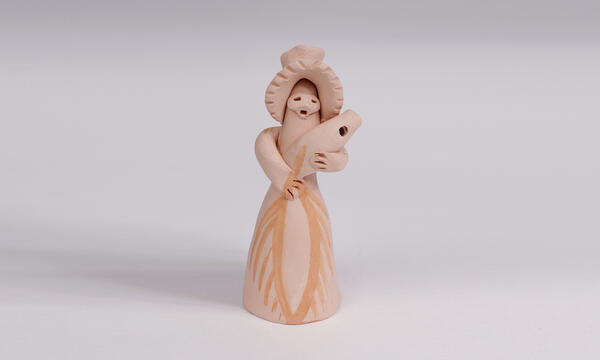‘Woman with a jug’ is the work of the Russian folk craftswoman Oksana Roshchupkina. The artist learned the craft of making clay toys with the help of Vladimir Lobyntsev’s notes, who in his turn picked up the skill in the 1980s and 1990s from the hereditary craftswomen Olga and Natalia Goncharova.
The toy’s design is based on the fragments of ancient figurines, which date back to the time when a fortress was founded in Oskol. At that time, the artisans who made tableware were ‘gorshkolepy’ (‘makers of pots’), and the craftsmen who made toys were called ‘svistyulishniki’ (‘makers of whistles’). In 1615, the manuscript records mentioned the names of seven state potters. By the end of the 20th century, their number increased to 172. Nowadays, folk artisans maintain the old traditions — the toys reflect the four-century history of the Oskol land.
In the past, potters called female figurines ‘baba’ (Russian name for a peasant woman). Since old times, clay figurines were believed to be the patrons of the clan, family, and women’s crafts. The Stary Oskol clay women usually wore a kokoshnik — according to an old tradition, no married woman should have her hair uncovered. There is a word in Russian which used to mean “having one”s head uncovered’. Today it means ‘to make a mistake’ based on the old belief that a woman should always wear a headdress.
Oksana Roshchupkina attached a kokoshnik to the figurine’s head and decorated it with an “ochelye” (the semicircular top piece above the forehead). According to the Stary Oskol tradition, a woman’s ochelye completely surrounded her face. The edge of the ochelye was scalloped; special tools — various pointed sticks — were used to model it. The Goncharov sisters, who served as an example for the young artisans, sometimes worked with the nail of the index finger.
The vast majority of researchers note that artists used to pay much more attention to modeling forms than to painting toys. If the toy was painted, soft shades were used. Various Russian craftsmen made use of natural dyes. Artists mainly used the mineral ochre dye. Since the 19th century, the clay toy became more and more decorative and ornamented.
The toy’s design is based on the fragments of ancient figurines, which date back to the time when a fortress was founded in Oskol. At that time, the artisans who made tableware were ‘gorshkolepy’ (‘makers of pots’), and the craftsmen who made toys were called ‘svistyulishniki’ (‘makers of whistles’). In 1615, the manuscript records mentioned the names of seven state potters. By the end of the 20th century, their number increased to 172. Nowadays, folk artisans maintain the old traditions — the toys reflect the four-century history of the Oskol land.
In the past, potters called female figurines ‘baba’ (Russian name for a peasant woman). Since old times, clay figurines were believed to be the patrons of the clan, family, and women’s crafts. The Stary Oskol clay women usually wore a kokoshnik — according to an old tradition, no married woman should have her hair uncovered. There is a word in Russian which used to mean “having one”s head uncovered’. Today it means ‘to make a mistake’ based on the old belief that a woman should always wear a headdress.
Oksana Roshchupkina attached a kokoshnik to the figurine’s head and decorated it with an “ochelye” (the semicircular top piece above the forehead). According to the Stary Oskol tradition, a woman’s ochelye completely surrounded her face. The edge of the ochelye was scalloped; special tools — various pointed sticks — were used to model it. The Goncharov sisters, who served as an example for the young artisans, sometimes worked with the nail of the index finger.
The vast majority of researchers note that artists used to pay much more attention to modeling forms than to painting toys. If the toy was painted, soft shades were used. Various Russian craftsmen made use of natural dyes. Artists mainly used the mineral ochre dye. Since the 19th century, the clay toy became more and more decorative and ornamented.





